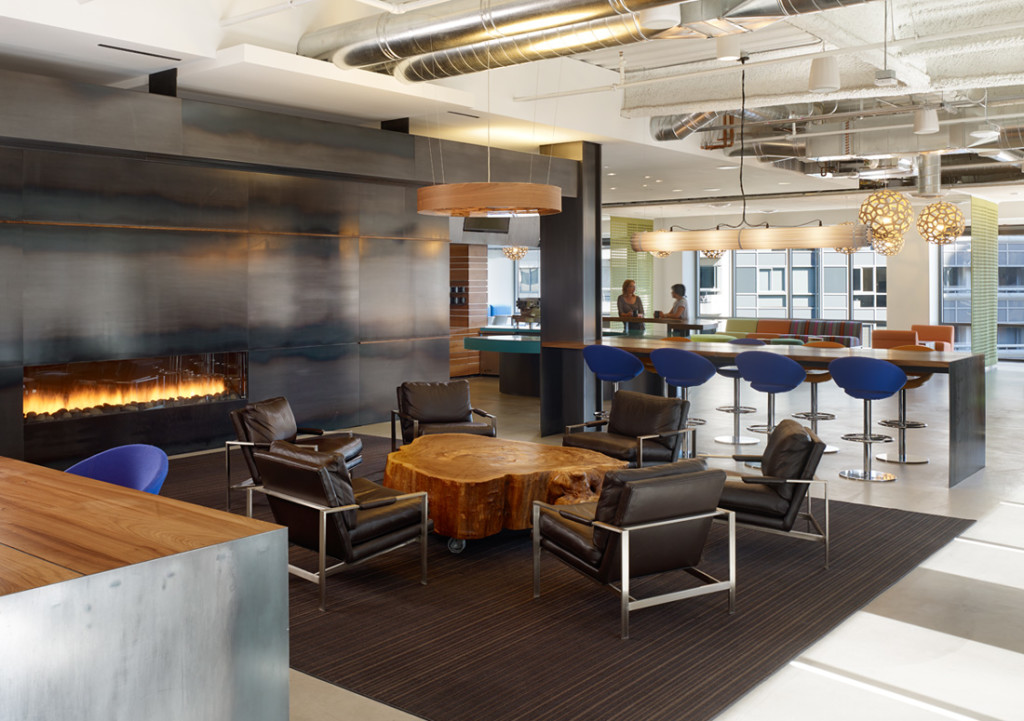By Robin Weckesser
Gas fireplace feature in New Relic’s headquarters in San Francisco, where Robin Weckesser and his team provided Project Management services.
Change management isn’t new, but today’s office dynamics are. To drive innovation and attract and retain top talent, companies are seeking creative, “cool” workplace solutions that offer a variety of amenities and the latest technology. Open offices continue to be the dominate choice for many reasons, including cost savings resulting from a reduced footprint, attraction and retention of talent, and the belief that openness promotes collaboration and productivity. Yet, while the office of the future is a reality today, many employees are anxious about change, and some are reluctant to give up their privacy.
The question is, how do we co-opt those who say they need walls? There is a time-tested method to address this challenge: change management. Without change management, the risk of damaging company morale and undermining performance is high, and this can harm the bottom line. So, with significant financial investments at risk, a comprehensive and customized change management strategy can be vital in the successful workplace transformation to an open environment.
Before we talk about how to develop and implement a change management strategy, it is important to note that the process begins with designing the kind of workplace that takes into account how space can best accommodate function. In other words, show employees that you have considered their task-related needs from the start!
Engage Employees
At its core, change management is about involving employees in the solution development and decision-making process. By giving them a voice, they will feel included and more receptive to change. This will also help ensure that the end result reflects their input, needs, and desires, which is critical as the line between work and home becomes more blurred.
How much you engage your employees depends on the extent of the transformation and the departure from your current space. However, regardless of the size of the project, it is important to involve your employees early on. Communication throughout the process will build trust and give employees time to digest and provide constructive feedback. In contrast, asking employees to adopt changes that they had no involvement in will likely cause friction and resistance.
For better or worse, the way changes are implemented will have a lasting effect on how employees feel about the company, with potentially adverse effects on your corporate culture and brand. Through change management, you have an opportunity to show employees they are valued and their voices are heard—this will support product and administrative teams, boost morale, increase productivity, strengthen the culture, and improve the bottom line.
Customize, Customize, Customize
There is no such thing as a one-size-fits-all change management plan, and an endless pool of options can engage employees in the decision-making process. Traditional methods include sending email updates, forming a core project team, interviewing key employees and stakeholders, and creating design mockups. More creative and tech-centric methods include podcasts, video updates, and an Intranet where employees can view plans and provide feedback.
When preparing your change management plan, think about:
- What is the company culture? If there is already a foundation of trust between employees and upper management, staff will feel more comfortable communicating concerns and be more receptive to change. If there is a divide, employees may see the proposed changes as a “top-down” decision they have no say in, causing resistance. In cases of extreme pushback, more drastic forms of engagement, like an employee summit, may be necessary to implement change.
- What are the demographics of your employee base? Most companies have a mix of Millennials, Gen X, and Baby Boomers—and increasingly, Generation Z is joining the workforce. With diverse experiences and tech know-how, each generation will likely have different concerns, and this should all be reflected in your proposed solutions.
- Tied to the above, how tech-savvy are your employees? The tools you use should reflect the forms of communication your employees are comfortable with. For a responsive, comprehensive plan, a mix of traditional and more modern methods is suggested.
- What is your budget? Be sure to incorporate both direct expenses like equipment and indirect expenses such as time your employees may need for interviews or meetings. A set budget will help you narrow your options.
Considering these points will help ensure your change management plan is customized for your company’s culture and budget.
Anticipate and Manage Pushback
Although the open office has become more mainstream, some employees, especially senior managers, may still feel uneasy about switching from private offices to collaborative space. While lack of privacy is a part of their apprehension, they may also fear that giving up their office means compromising their status.
As workplace design becomes less hierarchy-driven, it is important to assure people that their role within the company will still be recognized. Additionally, many don’t realize that open offices are often a hybrid of shared and private space that meets a wide range of needs. So, be prepared for initial pushback and possible anger from employees, but keep in mind that with proper communication, education, and patience, you can change their perspective.
Numerous companies experience similar pushback during office transformation, and each has to factor in budget and cultural considerations to get employees on the same page. From workplace design retreats with key employees to company-wide lunch meetings, effective ways to shift attitudes include visual and hands-on approaches such as:
- In guided workshops, activities can help staff look at how they work today and how they could work in alternative settings. Employees might be asked to visualize and create their perfect office. They might be provided with tools to model that ideal space, such as pipe cleaners, Legos, construction paper, and other building materials. Working in teams or alone, this will encourage employees to think differently about how they work and will also give you and your team critical feedback.
- Take employees on a tour of alternative office environments. This may be within the company on another part of campus or with a different company. Give them time to chat with employees who can help ease their fears and address their concerns about privacy and distractions.
- Present proposed changes to employees through digital models, blueprints, or PowerPoint presentations. Then, candidly review the designs and address needs and concerns. Ask them what they would change and why, if they think anything is missing or unclear.
This approach will help employees see how open designs can be more efficient and productive, while still offering a degree of privacy. It can also shift your employees’ viewpoint about the planned changes and serve as great team-building exercises.
Transform Your Workplace
As technology and workplace demographics continue to evolve, the office will continue its transformation to accelerate the production cycle, attract and retain talent, and optimize performance. No longer tethered to our desks by a wire, we will become a more mobile workforce with employees enjoying more of a “Live-Work-Play” lifestyle.
Project management and change management are no longer separate entities. They must work in synch from start-to-finish to ensure successful projection execution. While some companies have a project management discipline in-house, companies typically outsource this function to specialists. So, plan ahead and consider an experienced project management firm that provides change management as a part of its services.
No matter your industry or location, with patience, due diligence, and a customized change management program, you can make the workplace of the future work for you today.






Sorry, the comment form is closed at this time.